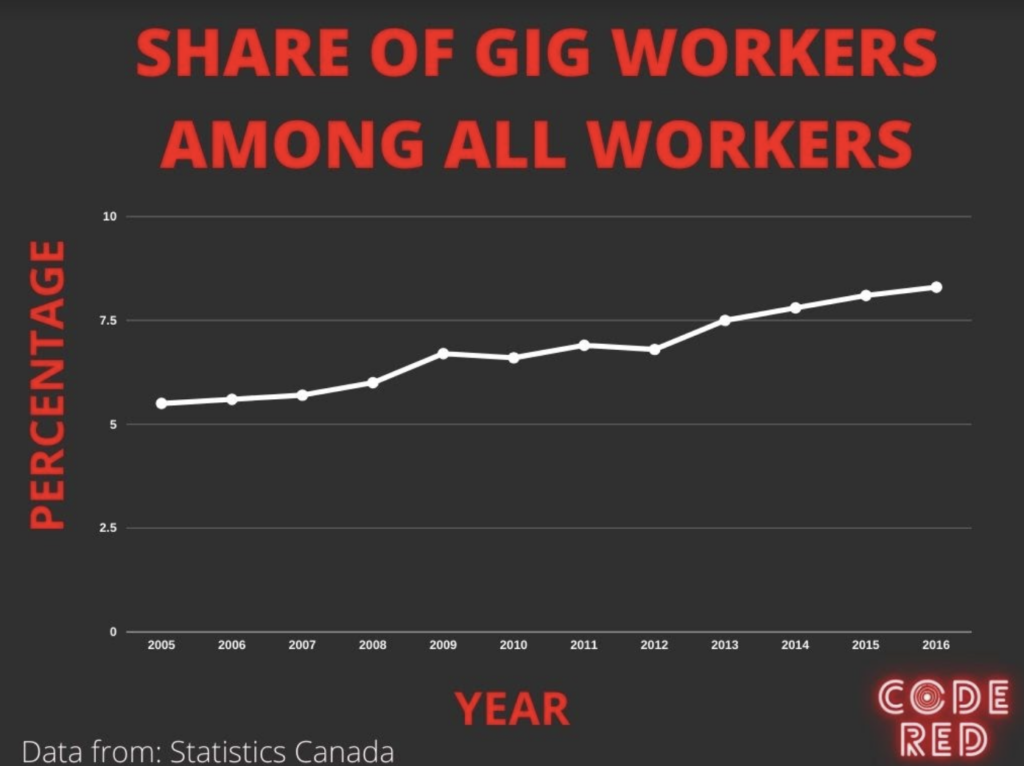
A rise in gig work is contributing to record levels of inequality in Toronto, leaving young people entering the workforce without a safety net, according to a data expert who has studied the growth of the city and how it has affected marginalized communities.
Steven Ayer, an author of the 2021 Vital Signs Report, said rises in non-full-time work contribute to inequality, in part because they’re low paid and in part because they mean younger people entering the workforce may be unlikely to have access to social safety nets allotted to previous generations.
“When we look at jobs that are temporary, they tend to be lower pay. They tend not to have pensions, benefits, sick leave and all these things contribute to inequality,” said Ayer. “And as we see these jobs growing it does mean that a greater percentage of folks are likely not having a lot of critical coverage.”
Young people and others entering the workforce are also more likely to end up working in the gig economy.
“So you’re entering these markets where half the jobs are temporary or self-employed, whereas traditionally across the entire labour market about 20 per cent of jobs are temporary or self-employed,” said Ayer. “And so, if you’re a younger person that’s what you’re going to be stuck with.”
He said an earlier report — the 2019 Vital Signs — indicates that temporary jobs grew five times faster than permanent jobs, while self-employment grew three times faster and part-time jobs grew two times faster than full-time jobs.
Ayer, who is the founder and CEO of Common Good Strategies Consulting, led the research and writing for Toronto’s Vital Signs Report, which has been referred to as the “city’s report card.” The Vital Signs report is issued by the Toronto Foundation, a charity that works with community organizations to increase the quality of life in the city.
Data used in the report is based on the Labour Force Survey, a household survey conducted by Statistics Canada, which doesn’t explicitly separate gig workers from other work, said Ayer. However, the report does focus on temporary workers, part-time workers and self-employed workers, which are considered gig work.
Ayer said that temporary workers, gig workers and the precariously employed were also disproportionately laid off during the pandemic.
“So it was disproportionately gig workers who were experiencing the most financial consequences of the pandemic and really they were the slowest to recover,” said Ayer, adding that when gig workers lose their jobs, they often do not have a financial safety net since many are not eligible for government support programs and generally have fewer savings to rely on.
According to a Statistics Canada study, eight to 10 per cent of all Canadian workers were involved in the gig economy in 2016. This was split equally between full-time gig workers and those supplementing their existing income with gig work.

The study found that yearly earnings for the majority of gig workers was less than $5,000. For a quarter of those workers, their gig earnings represented their entire yearly earnings.
Saurabh Sharma is a gig worker and law student at Ryerson University. Sharma started as a gig worker last September, initially working for DoorDash. After two months on the job, DoorDash suspended his account, he said. Since then, he began working for Uber.
Sharma said safety measures for couriers were lacking, and there was a sense of insecurity among the workers. Contributing to that sense of insecurity, Sharma said, was the fact that it was not mandatory for customers to wear a mask.
“I started feeling this frustration of not being able to communicate what I’m going through to anyone, because when you’re working as a delivery worker your boss is an app and your workplace is quite isolating,” said Sharma. “There is no sense of community where you can meet and talk to others, especially during the winter months.”
Gig work in the delivery industry is more precarious on the street, said Sharma, as busy roads come with a heightened chance of injury compared to other means of employment.
“And when you don’t have something as basic as employment insurance, there is no security that you will make money tomorrow, next month, or not,” he said.
Many gig workers do not have access to employment insurance (EI). According to Statistics Canada, half of all gig workers are ineligible for regular EI benefits. Despite existing EI benefits for self-employed individuals, few gig workers were eligible for these benefits during the pandemic.
Sharma’s frustrations with gig work during the pandemic led him to discover Gig Workers United, an advocacy group for app-based delivery workers.
Among other things, the group advocates for the Gig Workers’ Bill of Rights, a document outlining individual rights they said should be adopted. These include full employment rights, compensation for work-related expenses, payment for all hours worked and more.
Sharma said the group “has been kind of a lifesaver in a way,” where workers can discuss their problems together and find a common sense of purpose.
Sharma said he has concerns about the rise of gig work broadening inequality.
“It’s one of the biggest industries right now employing this many people,” said Sharma. “So these are workers who are working without full worker rights, which is bound to create inequality because these are the workers who don’t have insurance.”
He also said workers do not have paid sick days and are not guaranteed a minimum wage.
“And if more and more people are employed in this economy and if this is how this economy’s gonna run that’s going to broaden the divide,” said Sharma. “Many people are being forced into this economy.”
According to the Statistics Canada study, the gig economy grew from six per cent to 6.8 per cent from 2008-09, in the aftermath of the 2008 recession. During that time there was a net loss of 400,000 jobs in Canada, according to Statistics Canada. The study said it is too early to tell if this same trend will occur due to the COVID-19 pandemic.
“We can only speculate about it because there is no data,” said Yuri Ostrovsky, a senior research analyst at Statistics Canada and an author of the study.
However, he says, some things are already apparent.
“We know that the accommodation industry, the food and drink sector, have been very hard hit by the pandemic,” said Ostrovsky. “So it’s logical to conclude that a lot of gig workers in that industry would not be able to continue their work.”
The arts and entertainment industry was particularly affected by the pandemic, said Ostrovsky, where more than a quarter of employees are gig workers.
Daniel Johnson was the Business Editor of On The Record in the Fall 2021 semester.

